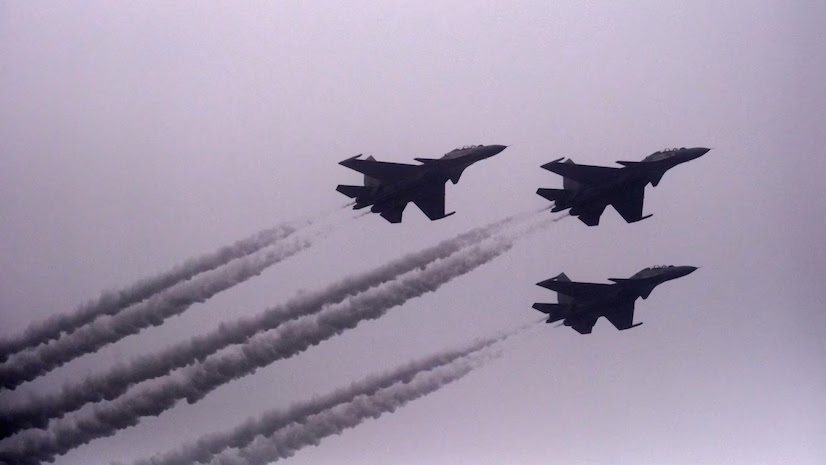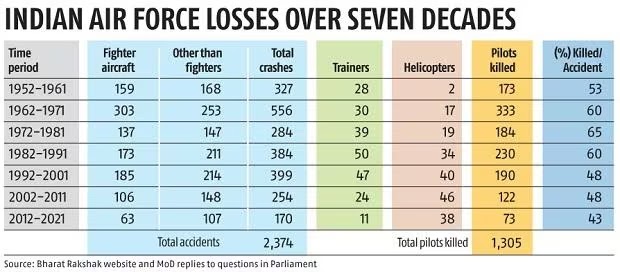
Single-engine, Soviet-era combat aircraft are being rapidly replaced by twin-engine, Western bloc aircraft. What does this mean for the IAF?
By Vikas Gupta and Devesh Kapur
Defence News of India, 1st Sept 2023
One of the most worrying shortfalls in India’s defence preparedness is in the Indian Air Force’s (IAF’s) fleet of combat aircraft. The Ministry of Defence (MoD), the IAF itself and air power experts in and outside the country have acknowledged the requirement of about 42.5 squadrons of combat aircraft, which include fighters, bombers and electronic warfare aircraft. There is vocal lament over the deficiency of 10-12 combat squadrons, which, given that each squadron is authorised 21 aircraft, amounts to a deficiency of 210-252 aircraft. Many argue that this figure is misleading and that the enhanced capabilities of contemporary combat aircraft compensate for the IAF’s numerical arrears. Whatever the merits of that argument, it is evident that the IAF’s plight stems, to a significant degree, from its unacceptably high accident rate, which has steadily eroded its bank of combat aircraft as well as skilled pilots.

The MoD releases IAF accident figures from time to time, usually in response to questions by Members of Parliament. However, a more comprehensive tabulation is available on the Bharat Rakshak website, a privately-run website which scours the print and electronic media to log each accident as it occurs. Between these two sources, it is possible to obtain a reasonably accurate set of accident figures, which form the basis of this column.
We examine accident figures for the 70-year period from 1952 to 2021, which have been further divided into seven segments, each a decade long. During these seven decades, the IAF has lost 2,374 aircraft to crashes, including 1,126 fighters and 1,248 non-combat aircraft. In addition, 229 trainers and 196 helicopters have crashed. These crashes have resulted in the deaths of 1,305 skilled pilots, each of whom has cost the government several crores of rupees. The number of combat aircraft lost exceeds 50 squadrons.
Some of these aircraft and pilots were lost in action in the wars that India fought against Pakistan in 1947-48, 1965 and 1971; and to a smaller extent in the Kargil conflict in 1999. In the 1962 war, the IAF did not fly combat operations. In the 1965 war, it lost 59 aircraft on the ground, many during pre-emptive strikes by the Pakistan Air Force (PAF) in Pathankot and Kalaikunda, in what turned out to be a deplorable failure of Indian intelligence and preparedness. The IAF’s own history of its operations in the 1965 war acknowledges it “suffered disproportionately higher losses” than the PAF. A mitigating factor in 1965 was that the IAF was flying vintage aircraft while the PAF had the most advanced US fighters in Asia. With greater experience, the IAF did much better in the 1971 war. Overall, of all the IAF’s losses, just 143 aircraft – or one out of eight aircraft lost overall – were combat casualties.
Only about two decades ago was the IAF able to bring its accident numbers under control. But that leaves the question: What explains the IAF’s acceptance of half a century of colossal aircraft losses as well as the deaths of so many pilots? To what extent is the long-term bleeding from peacetime accidents responsible for the persisting shortfall of combat squadrons. This question must be answered, given the exorbitant cost of combat aircraft, as well as the expenditure on training fighter pilots. Through practically the entire decade of the 1990s, the IAF bled from losing an average of two aircraft and a pilot every month. An audit report, entitled “Aircraft Accidents in the Indian Air Force, 2002”, by the Public Account Committee concluded that the IAF’s accident rate per 10,000 hours of flying ranged “between 0.89 and 1.52 during the period 1991-97”; for fighters it “ranged between 1.89 and 3.53”; while for MIG-21 variants it “ranged between 2.29 and 3.99”.
In comparison, fighter aircraft accident rates in the US Air Force were 0.29 in the 1990s, 0.15 in the 2000s and 0.1 between 2010-18.
A debate in Parliament in 1982 reflected concerns that the IAF had lost nearly as many aircraft in accidents in just the previous two years as in the entire 1971 war. Since then numerous committees have periodically examined the issue. Three causes of accidents were broadly identified: Human error, technical defects and nature, which includes hostile weather and bird hits. Technical defects included poor maintenance and the non-availability of spare parts, especially for MIG variants after the collapse of the Soviet Union. But they also reflected the obsolescence that inevitably crept in from flying aircraft like the decades-old MiG-21s that were already being ridiculed as “flying coffins” and “widow makers”.
Even in those years, it was evident that about half the IAF’s crashes were ascribable to human error. Reports indicated lapses in basic training and repeated failures to upgrade the HPT-32 Stage-1 trainer aircraft on which IAF pilots learned the A-B-C of flying. The 1980s and 1990s recorded alarming numbers of trainer aircraft crashes, with higher fatalities as a consequence of both the trainer and the trainee pilot perishing. The IAF grounded the HPT-32 only after 19 pilots were killed in 17 accidents over 23 years of flying. Hindustan Aeronautics Ltd (HAL) pushed hard to design and build a basic trainer – the Hindustan Turbo Trainer 40 (HTT-40) – but the IAF lost valuable years advocating for the Swiss Pilatus PC-7 Mark II. It would take 229 trainer aircraft crashes, over three decades, before the Pilatus PC-7 Mark II was inducted in 2013 for Stage I training. And only now has HAL been given the green light to build the HTT-40 in numbers.
Amidst this policy meandering, an investigative committee found that the primary cause of MiG-21 accidents was the non-availability of advanced jet trainer (AJT) aircraft. An AJT would allow pilots to graduate slowly, through advanced Stage III training on jet aircraft, to the notoriously fast MiG-21 which is also difficult to fly. Yet, it took a quarter century for the British-built Hawk AJT to be inducted for Stage III training of IAF fighter pilot aspirants. This led to a marked decline in crashes, although that was also due to the gradual phasing out of the older MIG-21s.
With the IAF having now entered a new era, in which single-engine, Soviet-era combat aircraft are being rapidly replaced by twin-engine, western bloc power plants, it remains to be seen whether fighter aircraft and fighter pilots are spared the erosion of men and materials which makes air combat so hazardous in the India-Pakistan-China context.






